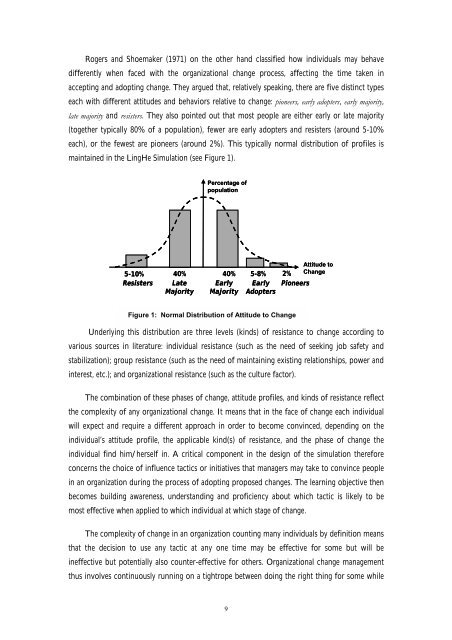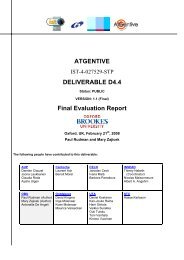LingHe Simulation - INSEAD CALT
LingHe Simulation - INSEAD CALT
LingHe Simulation - INSEAD CALT
Create successful ePaper yourself
Turn your PDF publications into a flip-book with our unique Google optimized e-Paper software.
Rogers and Shoemaker (1971) on the other hand classified how individuals may behave<br />
differently when faced with the organizational change process, affecting the time taken in<br />
accepting and adopting change. They argued that, relatively speaking, there are five distinct types<br />
each with different attitudes and behaviors relative to change: pioneers, early adopters, early majority,<br />
late majority and resisters. They also pointed out that most people are either early or late majority<br />
(together typically 80% of a population), fewer are early adopters and resisters (around 5-10%<br />
each), or the fewest are pioneers (around 2%). This typically normal distribution of profiles is<br />
maintained in the <strong>LingHe</strong> <strong>Simulation</strong> (see Figure 1).<br />
Percentage of<br />
population<br />
5-10% 40% 40% 5-8%<br />
Resisters<br />
Late<br />
Early<br />
Early<br />
Majority<br />
Majority<br />
Adopters<br />
Attitude to<br />
2%<br />
Change<br />
Pioneers<br />
Figure 1: Normal Distribution of Attitude to Change<br />
Underlying this distribution are three levels (kinds) of resistance to change according to<br />
various sources in literature: individual resistance (such as the need of seeking job safety and<br />
stabilization); group resistance (such as the need of maintaining existing relationships, power and<br />
interest, etc.); and organizational resistance (such as the culture factor).<br />
The combination of these phases of change, attitude profiles, and kinds of resistance reflect<br />
the complexity of any organizational change. It means that in the face of change each individual<br />
will expect and require a different approach in order to become convinced, depending on the<br />
individual’s attitude profile, the applicable kind(s) of resistance, and the phase of change the<br />
individual find him/herself in. A critical component in the design of the simulation therefore<br />
concerns the choice of influence tactics or initiatives that managers may take to convince people<br />
in an organization during the process of adopting proposed changes. The learning objective then<br />
becomes building awareness, understanding and proficiency about which tactic is likely to be<br />
most effective when applied to which individual at which stage of change.<br />
The complexity of change in an organization counting many individuals by definition means<br />
that the decision to use any tactic at any one time may be effective for some but will be<br />
ineffective but potentially also counter-effective for others. Organizational change management<br />
thus involves continuously running on a tightrope between doing the right thing for some while<br />
9
















